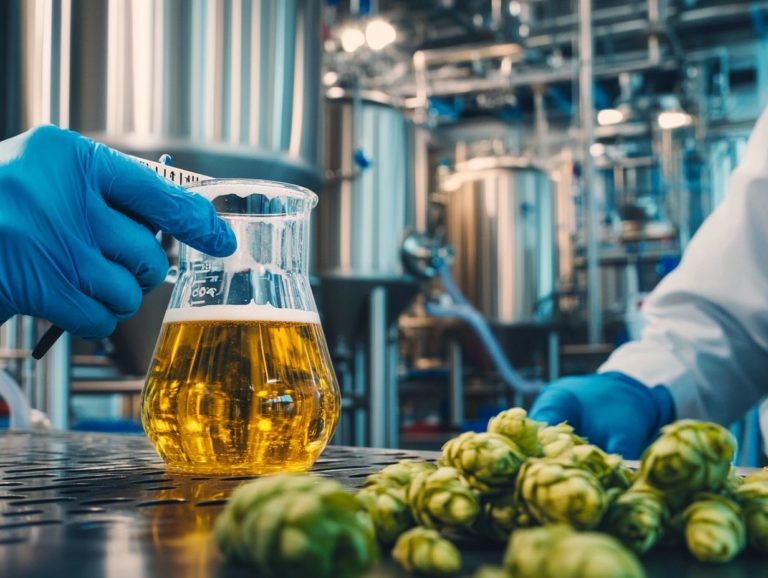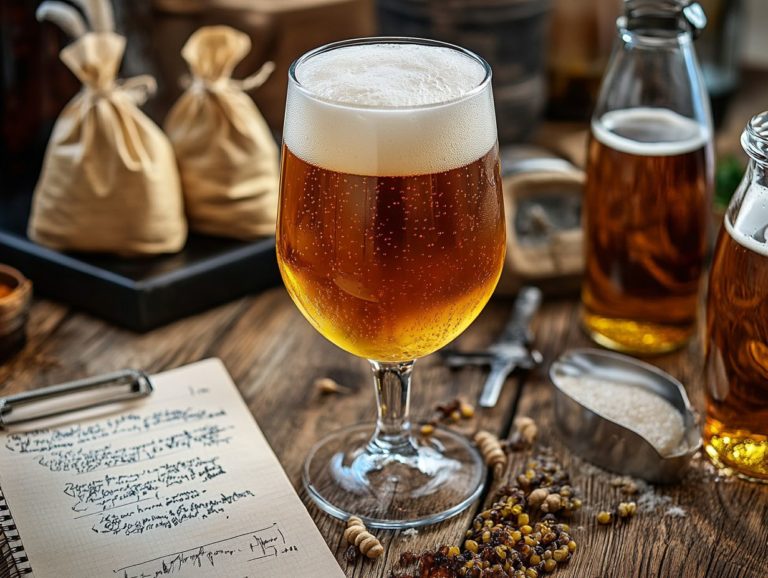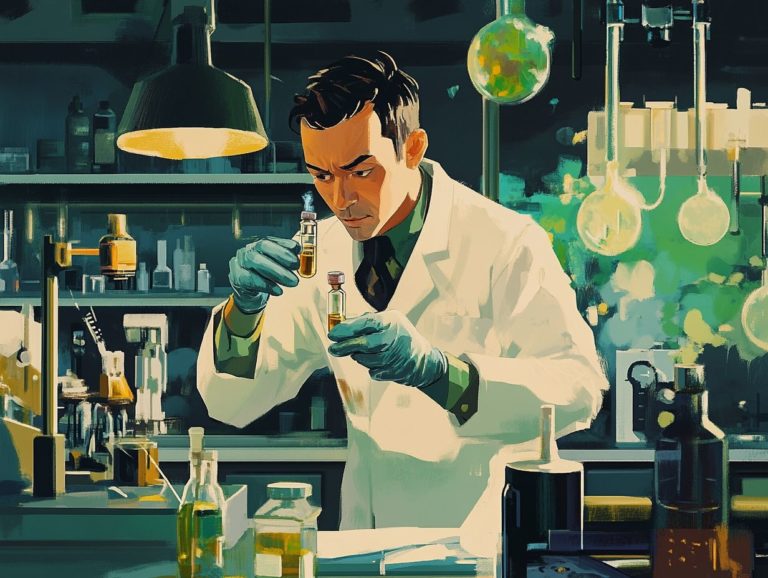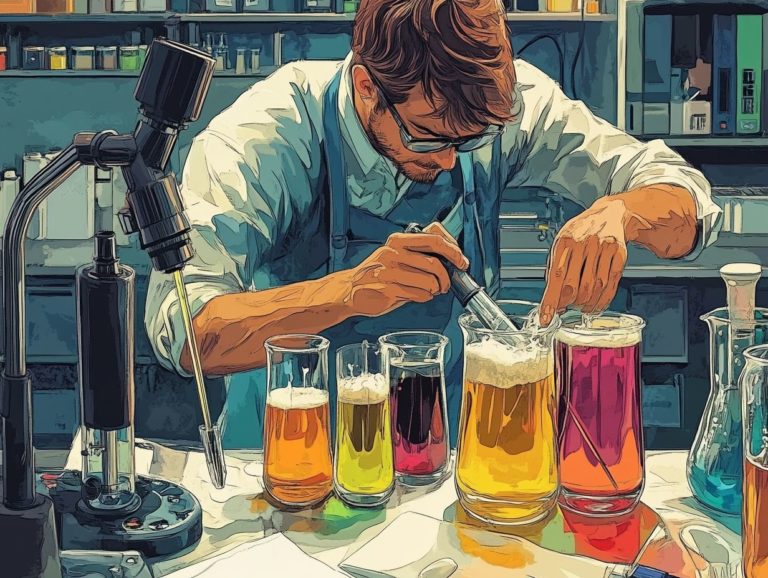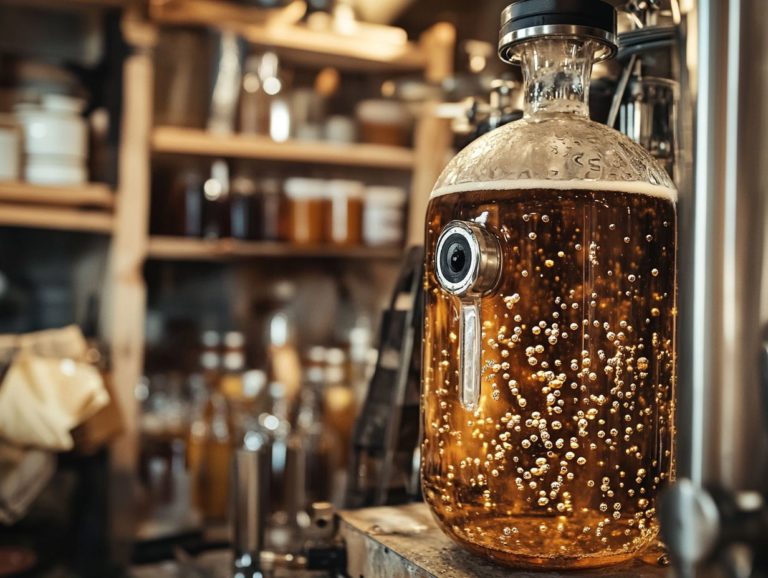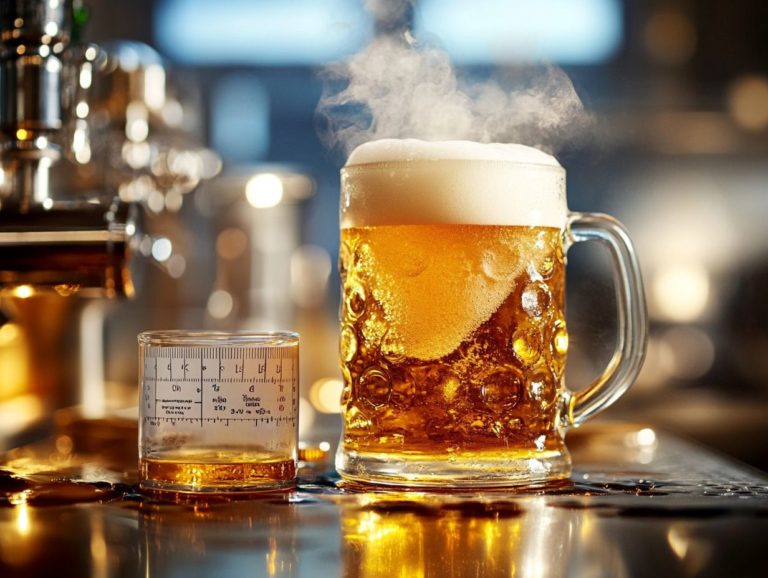How to Avoid Lightstruck Beer
Lightstruck beer, or beer affected by photodegradation, is a common concern for many beer enthusiasts, yet few truly grasp its implications on flavor characteristics and the overall drinking experience.
This article delves into the science behind lightstruck beer, revealing how both sunlight and artificial light can introduce unwelcome flavors and aromas that detract from your drinking experience. It highlights the signs to watch for, practical strategies to prevent this issue, and effective methods to salvage beer that has fallen victim to light exposure.
If you re eager to keep your beer tasting its absolute best, keep reading to uncover essential tips and insights that will elevate your appreciation for the art of brewing.
Contents
- Key Takeaways:
- What Is Lightstruck Beer?
- How Does Light Affect Beer?
- What Causes Lightstruck Beer?
- What Are the Signs of Lightstruck Beer?
- 3. Unpleasant Taste
- How to Prevent Lightstruck Beer?
- 1. Store Beer in Dark Places
- 2. Use Brown or Green Bottles
- 3. Choose Cans Over Bottles
- 4. Avoid Buying Beer Displayed in Direct Sunlight
- How to Tell if Your Beer Has Already Been Lightstruck?
- How to Save Lightstruck Beer?
- Frequently Asked Questions
Key Takeaways:
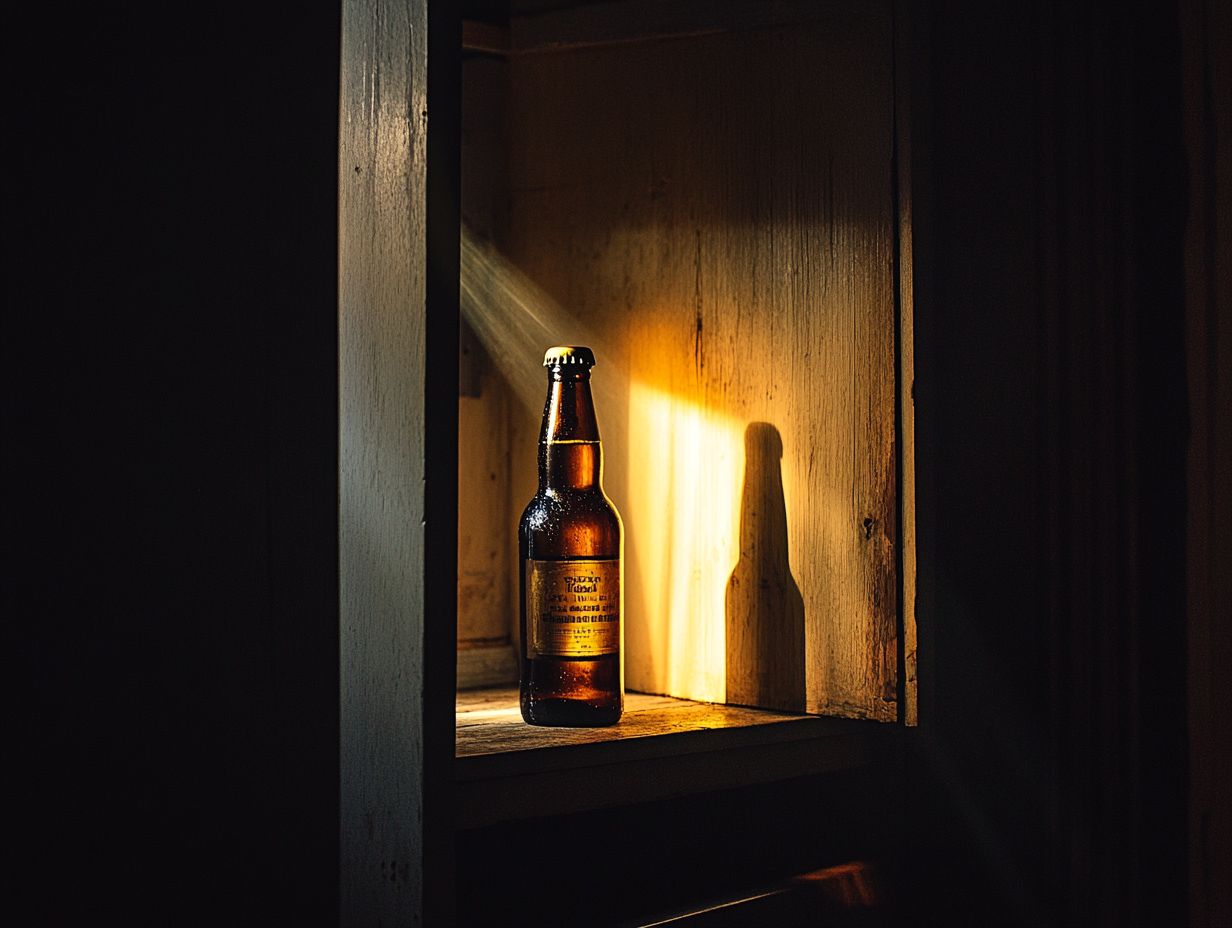
- Store beer in dark places to avoid light exposure, preserving its flavor stability.
- Choose beer in brown glass or green glass bottles, or cans, as they provide better protection against light exposure and photodegradation.
- Avoid buying beer displayed in direct sunlight to prevent lightstruck beer and its associated skunky aroma caused by 3-methylbut-2-ene-1-thiol (3-MBT).
What Is Lightstruck Beer?
Lightstruck beer refers to a type of beer that has developed off-flavors due to exposure to ultraviolet light. This exposure triggers a reaction with riboflavin and isohumulones, resulting in a distinct skunky aroma caused by the compound 3-methylbut-2-ene-1-thiol (3-MBT). Understanding this phenomenon is crucial for anyone who wants to appreciate their beer fully.
This flavor defect doesn t just alter your experience of the beer; it can also have a profound effect on its overall flavor stability and market trends, especially for bottled beers within the beverage industry. Brands like Corona, Heineken, and Miller are particularly aware of this issue.
How Does Light Affect Beer?
Light exposure, particularly ultraviolet light, profoundly affects beer, causing the photodegradation of essential flavor compounds. This process can introduce unwanted flavor defects, ultimately compromising the beer’s true taste, aroma, and the overall enjoyment of your tasting experience.
By grasping the brewing chemistry related to light’s influence on beer, including the roles of tetrahydroisohumulones and dihydroisohumulones, you empower brewers to develop more resilient formulations that can effectively withstand these detrimental effects.
What Causes Lightstruck Beer?
Lightstruck beer emerges from a delicate interplay of factors, chiefly the exposure of beer to ultraviolet light. This exposure sets off chemical reactions involving riboflavin and various sulfur compounds during the brewing process.
When beer is bottled in clear glass or green glass, it becomes especially vulnerable to these reactions, resulting in the creation of 3-methylbut-2-ene-1-thiol (3-MBT), a sulfur compound responsible for that notorious skunky aroma associated with lightstruck beer.
1. Exposure to Sunlight
Exposure to sunlight is one of the main culprits when it comes to lightstruck beer. Ultraviolet rays penetrate the brew and kick off chemical reactions that create off-flavors, particularly that distinct skunky aroma linked to 3-methylbut-2-ene-1-thiol (3-MBT). This reaction happens quickly, especially in beers that come in clear or green glass, underscoring the necessity for proper storage methods to preserve flavor integrity.
Sunlight emits specific wavelengths, especially ultraviolet (UV) light, which can wreak havoc on the delicate compounds in your beer. Craft beers, like lagers and pale ales, are especially at risk due to their lighter color and flavor profiles. For example, if you leave a refreshing pale lager in direct sunlight, it can swiftly develop those unwelcome off-flavors, completely spoiling your drinking experience.
To combat these risks, breweries typically opt for brown bottles or brown glass, which offer superior protection against harmful light exposure.
As a consumer, you should always store your beer in dark, cool places and steer clear of leaving it in direct sunlight, particularly during outdoor gatherings. Your taste buds will thank you.
Now that you know how to protect your beer from light damage, put these tips into action and enjoy every sip!
2. Exposure to Artificial Light
Artificial light is a sneaky contributor to the lightstruck phenomenon, particularly certain types of lighting that emit ultraviolet rays. This exposure can lead to the breakdown of beer’s ingredients due to light exposure, compromising flavor stability and creating unpleasant off-flavors that detract from your drinking experience.
You might be surprised to learn that common sources of harmful artificial light include fluorescent and LED fixtures, often found in retail environments and bars. Both of these can emit significant amounts of UV radiation. Even incandescent bulbs, though less prevalent today, also contribute to this dilemma.
Breweries and bar owners can adopt several strategies to combat light exposure, such as:
- Employing antioxidants to protect flavor stability.
- Choosing protective packaging that filters out harmful wavelengths.
- Ensuring minimal light exposure during storage.
- Opting for low-UV lighting options.
By implementing these measures, you can help preserve the delicate flavors and aromas that craft beer enthusiasts hold dear.
What Are the Signs of Lightstruck Beer?
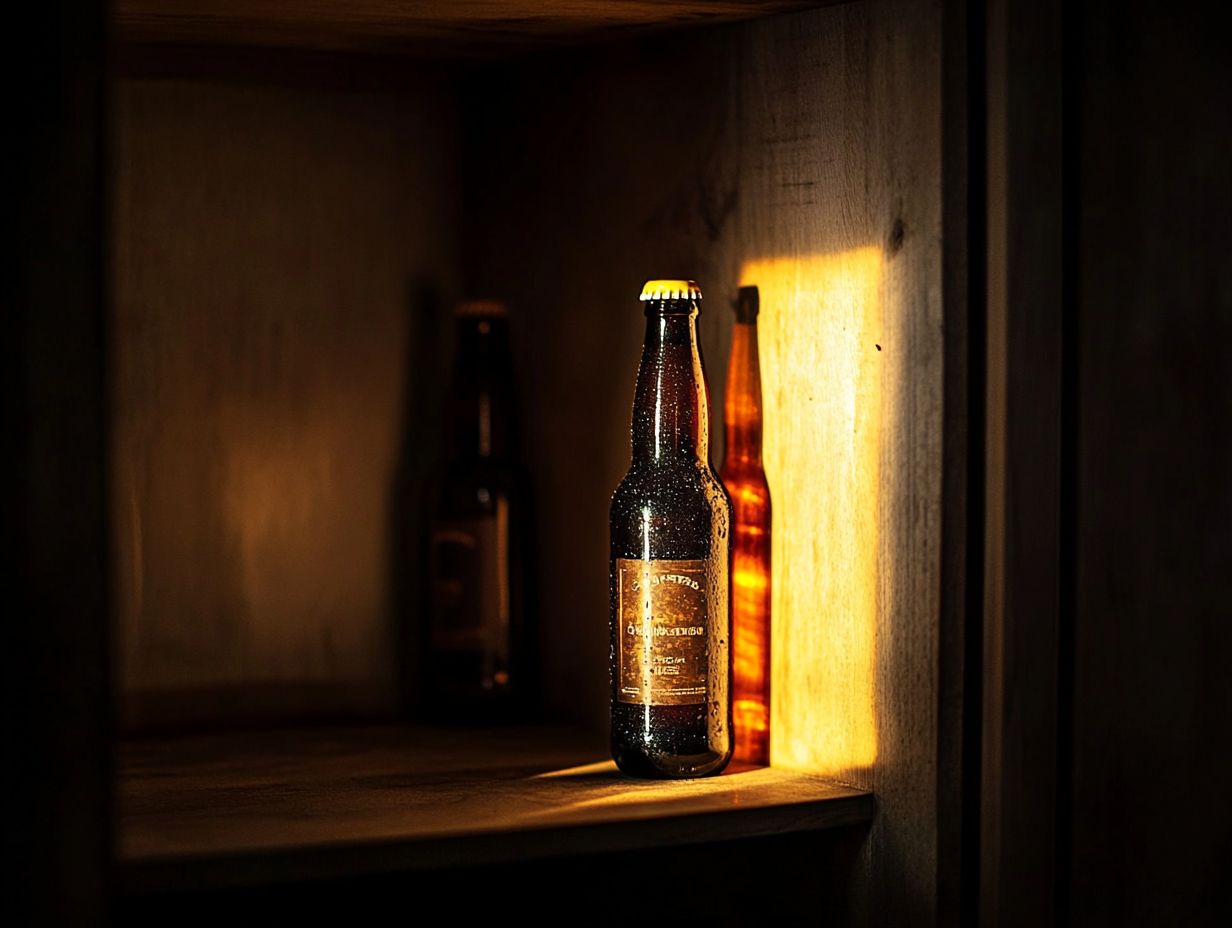
You ll quickly recognize the signs of lightstruck beer, which are unmistakable. The most prominent indicator is a skunky aroma that hits you right away. This is often accompanied by a cloudy appearance and a taste that strays far from the beer s intended flavor profile.
These telltale symptoms result from chemical reactions triggered by light exposure, particularly the creation of unwelcome sulfur compounds and other flavor defects that ruin your drinking experience.
1. Skunky Smell
A skunky smell marks lightstruck beer and primarily comes from 3-methylbut-2-ene-1-thiol (3-MBT). This sulfur compound arises when ultraviolet light interacts with riboflavin during brewing. This distinctive aroma can overshadow the beer’s intended flavors, significantly diminishing your overall sensory experience.
Encountering that skunky aroma hits your senses hard. It can overshadow the beer’s intended flavors. The unwelcome presence of 3-MBT not only alters your drinking experience but also impacts brand loyalty; you might find yourself avoiding light-struck options in favor of more aromatic, well-balanced alternatives.
For breweries, grasping this chemical reaction is vital. It goes beyond flavor and seeps into marketing strategies, packaging decisions, and ultimately, their reputation in a competitive market. Emphasizing the importance of proper storage and light protection helps maintain the product’s integrity, appealing to discerning beer enthusiasts who value quality above all else.
2. Cloudy Appearance
A cloudy appearance in your beer can be a clear sign of lightstruck conditions. When photodegradation occurs, it alters the clarity and visual appeal, creating a murky look that suggests a loss of flavor stability. This transformation often coincides with chemical changes that produce off-flavors, making it a crucial indicator for discerning beer enthusiasts.
When your beer is exposed to ultraviolet light, especially from clear or green bottles, certain compounds break down. This creates an unappealing haze and leads to the formation of those skunky flavors that no one really wants to taste.
Brewers who understand this relationship between light exposure and beer quality can take proactive steps, such as opting for darker packaging or using special additives to prevent degradation. As a consumer, you might find yourself steering clear of products that display this cloudy defect, associating it with poor quality or mishandling during storage. This perception can easily guide your choices, helping you pick the best beers available.
3. Unpleasant Taste
An unpleasant taste, often characterized by bitterness and an off-putting quality, signals that your beer has been lightstruck. This degradation of flavor compounds, caused by light exposure, can mask the delightful flavors that brewers meticulously craft. It turns a potentially enjoyable experience into a disappointing one.
When light interacts with specific compounds in the beer, especially those derived from hops, it triggers reactions that create off-flavors, including those infamous skunky notes. These can easily overshadow the carefully curated profiles of malt and hops you expect to savor. What was meant to be a beautifully balanced blend of citrus, floral, or caramel nuances can instead leave you with an unpleasantly harsh taste.
You might not realize that these unwelcome flavors are a result of inadequate packaging or storage. Such experiences can foster mistrust in certain brands, especially if lightstruck beers become a common encounter. Naturally, you gravitate toward beers that maintain their intended profiles. This prompts brewers to prioritize protective measures against light exposure. After all, ensuring a satisfying drinking experience is what keeps you coming back for more!
How to Prevent Lightstruck Beer?
Preventing lightstruck beer is essential for preserving its flavor integrity. There are several best practices you should embrace. Understanding the chemicals involved can provide valuable insights into maintaining high-quality beer.
Store your beer in dark places to shield it from both sunlight and artificial light exposure. Consider using brown or green bottles as they can greatly diminish the risk of photodegradation caused by ultraviolet light. Opting for cans might provide you with the highest level of protection against light exposure.
1. Store Beer in Dark Places
Storing your beer in dark places is one of the simplest yet most effective strategies you can employ to prevent lightstruck flavors. By minimizing light exposure, you significantly reduce the risk of flavor instability and degradation. This is due to the role of a compound that causes skunky aroma (3-methylbut-2-ene-1-thiol, or 3-MBT). Ideally, a cool, dark environment like a cellar or refrigerator can extend your beer’s freshness and preserve its intended flavor profile beautifully.
For many beer enthusiasts, a common challenge lies in keeping bottles away from light sources, particularly sunlight and artificial light sources. This requires an understanding of the visibility spectrum and the effects of ultraviolet light. This exposure can trigger unwanted chemical reactions that compromise the beer’s taste. Research has shown that even a brief encounter with light can result in skunky aromas, especially in lighter beers.
Take, for instance, the tale shared by one brewer about a seemingly innocent afternoon picnic. It s a classic case of how exposure to ultraviolet light can ruin a good batch of beer. A batch of light lager met its demise when left basking in direct sunlight. However, darker beers such as stouts and porters thrive in low temperatures and obscured storage, allowing their rich, complex flavors to fully develop.
By thoughtfully considering where and how to store these diverse varieties, you can ensure that every pour is as delightful as you intended. This involves understanding the brewing process and the impact of chemical reactions on flavor stability.
2. Use Brown or Green Bottles
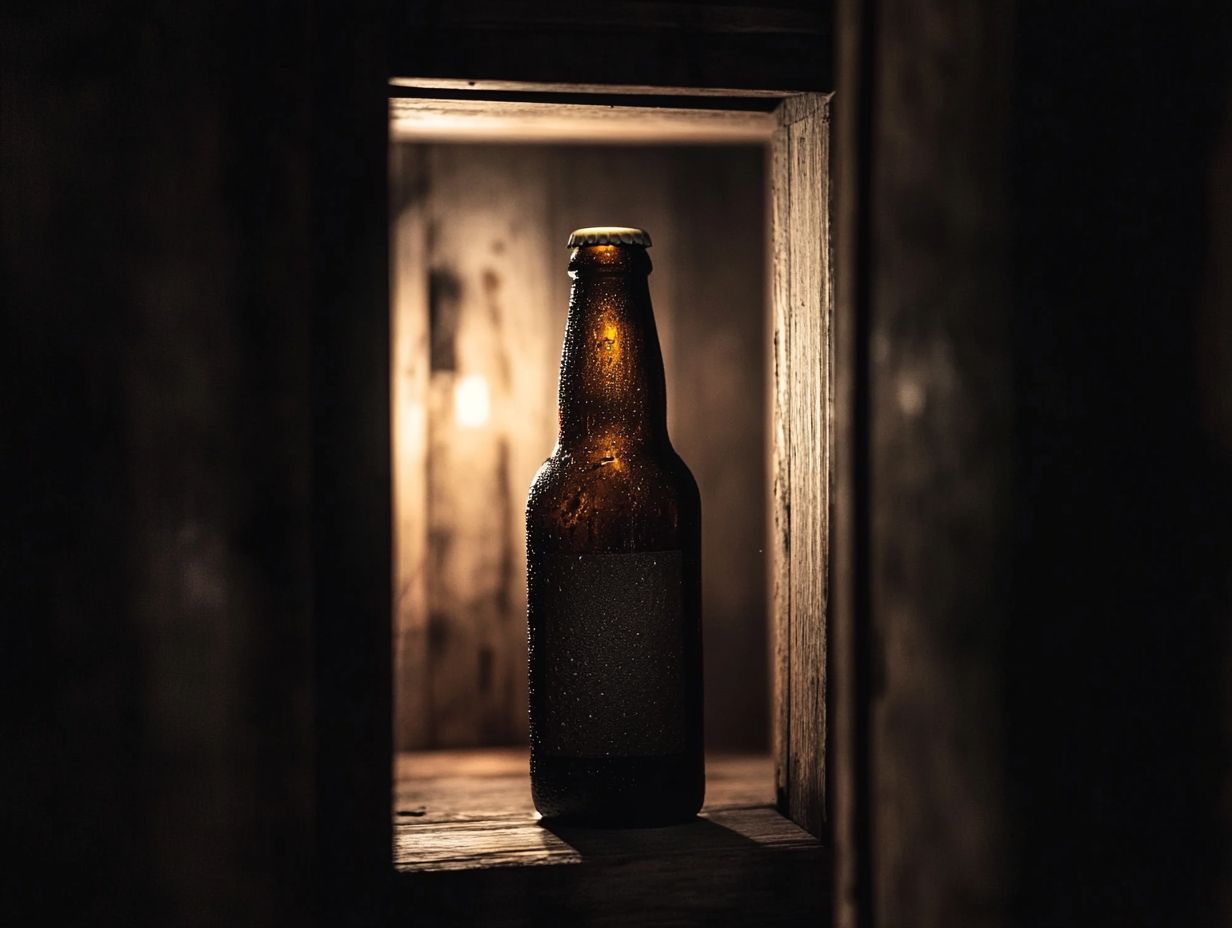
Using brown or green bottles is a smart move to protect your beer from light exposure. These colors effectively filter out harmful ultraviolet rays, minimizing the risk of those unpleasant skunky flavors or off-flavors that can arise from lightstruck conditions.
Breweries that take their packaging seriously often opt for these materials due to their protective qualities.
On the other hand, clear glass bottles offer little to no defense against UV light. This makes the beers inside more vulnerable to flavor degradation due to the chemical reactions involving riboflavin and isohumulones.
As an informed consumer, you should pay attention to the packaging when selecting a beer, favoring those in darker bottles to ensure a fresher tasting experience.
Labels can also be a treasure trove of information about the product’s expected shelf life, giving you insights into the brewery’s commitment to quality. Marketing departments often highlight the use of antioxidants and reduced iso-alpha acids to enhance flavor stability.
By understanding how bottle colors influence a beer’s preservation, you can make more knowledgeable choices and truly savor your beverages at their peak.
3. Choose Cans Over Bottles
Opting for cans over bottles is becoming a wise choice for anyone keen on preventing lightstruck beer, which is beer that has been spoiled by light. This choice is particularly beneficial as it avoids exposure to conditions that produce 3-MBT.
Aluminum effectively blocks all light, safeguarding your beer from both sunlight and artificial light sources. This not only provides superior protection for flavor stability but also helps maintain the beer’s original taste profile.
The portability of canned beer enhances its appeal, making it the perfect companion for outdoor activities, picnics, and gatherings. Additionally, cans are less prone to the effects of ultraviolet light compared to clear glass bottles.
You ll find that consumers are increasingly gravitating towards cans, with sales data highlighting a significant shift toward this packaging option in recent years. In fact, over 60% of craft breweries now offer their products in cans, driven in part by the belief that canned beer tastes fresher, thanks to its sealed environment that protects against oxidation.
As more beer enthusiasts discover the numerous benefits of cans from enhanced freshness to unmatched convenience you won t want to miss out on this rising trend that promises fresher beer!
4. Avoid Buying Beer Displayed in Direct Sunlight
Avoiding beer that has been displayed in direct sunlight is essential for you as a consumer. This exposure can compromise the flavor integrity long before it even reaches your home.
Retailers often underestimate the significance of proper storage. This makes it crucial for discerning beer enthusiasts like you to be vigilant when selecting your beverages.
To ensure you enjoy the best possible experience with each pour, seek out bottles and cans that are stored in cool, dark environments preferably on shelves shielded from harsh, bright lights. This helps to prevent the formation of skunky flavors caused by sulfur compounds and other flavor defects.
Keep an eye out for any signs of heat damage, such as bulging cans or unusual off-flavors, as these cues can guide you to make better choices.
Retailers hold a critical responsibility in safeguarding the quality of their products. They should prioritize proper refrigeration and utilize UV-protective glass for bottled options. Emphasizing the importance of brewing chemistry and degradation caused by light in flavor preservation is also beneficial.
Ultimately, being well-informed gives you the power to make educated decisions and steer clear of the unpleasant consequences associated with poorly stored beer. This preserves the intended taste and enjoyment that you deserve.
Make informed choices when purchasing beer to ensure the best tasting experience possible!
Lightstruck beer can be quite a challenge to salvage, but don’t worry! You can save your lightstruck beer with some simple tricks. Let’s bring the flavor back!
How to Tell if Your Beer Has Already Been Lightstruck?
To determine if your beer has fallen victim to lightstruck conditions, pay close attention to sensory perception cues and chemical reactions. These can include changes in the beer’s sensory attributes, such as aroma and taste.
A distinct skunky aroma, a cloudy appearance, and a taste that strays from the beer’s original flavor profile may all indicate potential flavor defects caused by chemical reactions from light exposure.
As a discerning consumer, it s essential for you to actively engage in both visual inspection and tasting methods when assessing your beer. Understanding the brewing process and the presence of flavor-active compounds can further aid in this evaluation.
Start by examining the bottle or can look for clarity and consistent coloration; any haziness could signal spoilage. When you pour, take note of the head; a lack of foam may correlate with undesirable changes.
When tasting, look out for off-flavors reminiscent of sulfur or cardboard, which are often telltale signs of lightstruck conditions. These flavors stem from the degradation of isohumulones and other flavor compounds.
Don t forget to consider the beer’s aroma any hint of mustiness or skunkiness should raise a red flag. By honing these skills, you can elevate your enjoyment of beer, approaching each sip with greater knowledge and appreciation.
How to Save Lightstruck Beer?
Lightstruck beer can be quite a challenge to salvage, but there are a few strategies you can employ to mitigate those unwelcome off-flavors caused by chemical reactions involving isohumulones and riboflavin.
Start by storing your beer in a dark place; this will help slow down any further degradation.
Opting for a dark bottle is another effective measure to block out additional light. This is crucial in preventing the formation of 3-methylbut-2-ene-1-thiol (3-MBT) and other skunky aromas.
If the skunky taste persists, consider adding a splash of lemon or lime juice to mask those undesirable flavors and bring back some semblance of stability to the brew.
1. Store in a Dark Place
Storing lightstruck beer in a dark place can significantly diminish the ongoing effects of light exposure. This simple step gives your beer a chance to regain its original taste and prevent further degradation of quality.
Many passionate beer enthusiasts and industry professionals stress the importance of light management as a vital component of beer preservation. This highlight emerges during conversations about brewing chemistry. Antioxidants play a critical role in maintaining beer stability.
A well-known brewery owner even recounted how investing in opaque storage containers revolutionized their inventory management and dramatically enhanced the taste profile of their creations.
Using cardboard boxes or specialized beer fridges is an excellent way to shield your beverages from harmful light, ultimately leading to a fresher and more enjoyable drinking experience. This is particularly useful in preventing the activation of sulfur compounds that lead to skunky off-flavors.
When transporting individual bottles, consider wrapping them in dark paper or cloth; even brief exposure to light can trigger undesirable off-flavors.
By taking thoughtful steps to address light exposure, you can ensure that your favorite brews retain their intended characteristics and deliver a delightful experience every time.
2. Use a Dark Bottle or Can
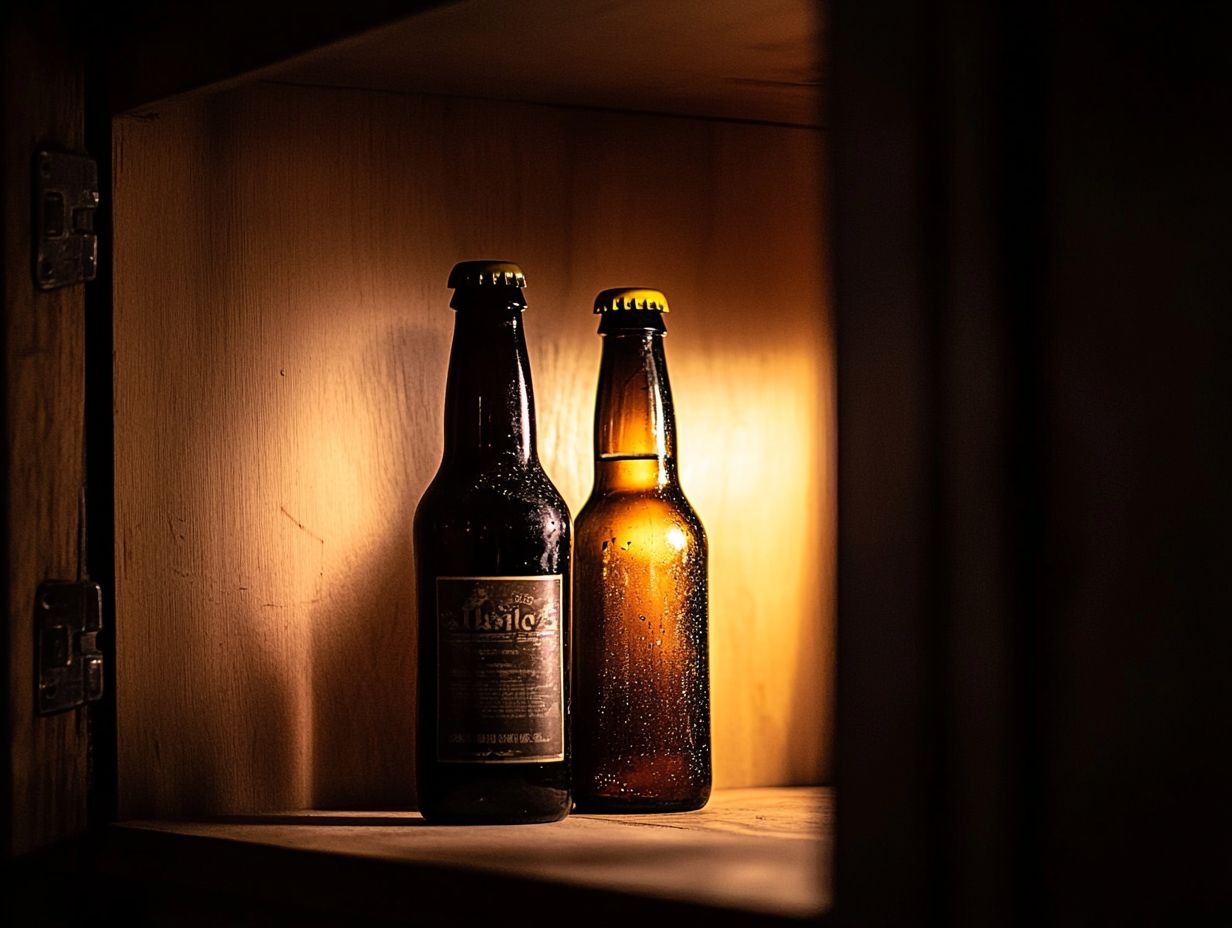
Utilizing a dark bottle or can is essential for safeguarding your beer from the risks of light exposure. These materials not only preserve the flavor but can also enhance the beer’s taste profile, particularly if it has experienced the harmful effects of light.
Such containers serve as a robust barrier against ultraviolet rays, which can lead to off-flavors. This ensures that the intended taste remains pristine for your enjoyment. It is particularly important for maintaining the integrity of the beer’s flavor compounds and stability.
Many craft breweries have recognized this necessity. They cater to the discerning palate of beer enthusiasts who seek a more reliable taste experience.
By opting for dark packaging, these producers appeal to a growing audience eager to savor the intricate profiles of their favorite ales and lagers. This helps avoid the unpleasant risk of skunky off-flavors caused by photodegradation and other chemical reactions.
The aesthetic appeal of dark bottles and cans adds to their charm, making them a stylish choice for those wishing to make a statement at social gatherings.
3. Add a Dash of Lemon or Lime Juice
A dash of lemon or lime juice can be your secret weapon against lightstruck beer, helping to mask those unpleasant skunky flavors while adding a refreshing twist. This addition is particularly effective against the sulfur compounds that contribute to off-flavors.
This simple addition not only makes the brew more enjoyable but also introduces new flavor profiles that can distract from the original defects.
This technique is a favorite among beer enthusiasts who have faced the unfortunate consequences of sunlight on their beloved brews. Many craft beer fans have shared their experiences, revealing that a splash of citrus can truly revive a drink and beautifully complement the floral and hoppy notes that first drew them in.
For example, at tasting events, you might notice participants raving about how a hint of grapefruit can transform an otherwise lackluster lager into a surprisingly delightful experience. The bright acidity of citrus interacts wonderfully with the lingering bitterness, creating a new harmony that celebrates the beer’s original intent, even in lightstruck conditions.
Frequently Asked Questions
What does it mean if my beer is lightstruck?
Lightstruck beer, also known as skunked beer, is beer that has been exposed to UV light, causing it to develop a foul, skunky smell and taste.
Why should I avoid lightstruck beer?
Lightstruck beer can be highly unpleasant to drink and can ruin the flavor of your beer. It is also a sign of poor quality and indicates that the beer has been improperly stored or transported.
How can I tell if my beer is lightstruck?
The easiest way to tell if your beer is lightstruck is by its smell and taste. If it has a strong skunky odor or flavor, it is likely lightstruck. Additionally, if your beer is in a clear or green bottle, it is more susceptible to being lightstruck.
How can I prevent my beer from becoming lightstruck?
The best way to prevent your beer from becoming lightstruck is to avoid exposing it to UV light. This means storing your beer in a cool, dark place and avoiding direct sunlight. It is also best to choose beer in brown bottles, as they offer better protection against UV rays.
Can I still drink lightstruck beer?
While lightstruck beer may not taste as good as properly stored beer, it is not harmful to drink. However, if the skunky flavor is too unpleasant for you, it is best to avoid drinking it.
What should I do if I accidentally expose my beer to UV light?
If you accidentally expose your beer to UV light, the best course of action is to drink it as soon as possible. The longer the beer is exposed, the stronger the skunky flavor will become. Alternatively, you can transfer the beer to a brown bottle or store it in a dark place to reduce the effects of light exposure.

